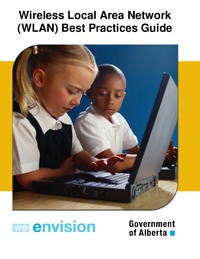Wireless Local Area Network (WLAN) Best Practices Guide |

|
 Diese Seite wurde seit 5 Jahren inhaltlich nicht mehr aktualisiert.
Unter Umständen ist sie nicht mehr aktuell.
Diese Seite wurde seit 5 Jahren inhaltlich nicht mehr aktualisiert.
Unter Umständen ist sie nicht mehr aktuell.
 Zusammenfassungen
Zusammenfassungen
 This guide is for IT directors and network personnel who are responsible for deploying and managing wireless related infrastructure and supporting laptops and mobile devices in the classroom. It is focused on WLANs and associated wireless technology. All levels of IT staff at both the district and local school level can benefit from information included in this guide. The guide has been updated to reflect technological updates in wireless networks.
This guide is for IT directors and network personnel who are responsible for deploying and managing wireless related infrastructure and supporting laptops and mobile devices in the classroom. It is focused on WLANs and associated wireless technology. All levels of IT staff at both the district and local school level can benefit from information included in this guide. The guide has been updated to reflect technological updates in wireless networks. This guide is focused on WLANs and associated wireless technology. When addressing key aspects of technology such as WLANs, a comprehensive and holistic approach is required in order to truly derive an overall understanding of the complex, integrated and inter-dependent aspects of IT. Hence, further to wireless technology, the guide also delves into security issues. This area should be further addressed in order to gain a comprehensive understanding and view of wireless technology’s role within your district’s overall IT strategy.
This guide is focused on WLANs and associated wireless technology. When addressing key aspects of technology such as WLANs, a comprehensive and holistic approach is required in order to truly derive an overall understanding of the complex, integrated and inter-dependent aspects of IT. Hence, further to wireless technology, the guide also delves into security issues. This area should be further addressed in order to gain a comprehensive understanding and view of wireless technology’s role within your district’s overall IT strategy. Four years ago, the original Wireless Local Area Network (WLAN) Best Practices Guide was released as WLANs began to be installed in Kindergarten to Grade 12 schools in Alberta. At that time, Alberta Education was launching the Emerge One-to-One Laptop Learning Initiative, and needed to provide technical advice to participating school authorities on best practices for implementing wireless networks. This advice was shared in the format of a best practices guide to allow all school authorities access the information.
Four years ago, the original Wireless Local Area Network (WLAN) Best Practices Guide was released as WLANs began to be installed in Kindergarten to Grade 12 schools in Alberta. At that time, Alberta Education was launching the Emerge One-to-One Laptop Learning Initiative, and needed to provide technical advice to participating school authorities on best practices for implementing wireless networks. This advice was shared in the format of a best practices guide to allow all school authorities access the information.Today, the wireless landscape continues to change. A growing number of devices rely on access to wireless networks to access information and run applications. The average user of these mobile devices now expects to have access to information at their fingertips, which is enabled by growing access to free wireless networks. The user who at one time had to pay to use Wi-Fi at airports, coffee shops and other public places now gets it for free with their coffee, groceries or boarding pass.
Within schools, the combination of wireless technology’s relatively low cost and easy deployment has led many districts implementing wireless technology without adequate up front planning and without addressing ongoing support requirements. This has often led to degraded levels of service and significant security exposures, dramatically increasing failure rates of user adoption and hindering seamless usage.
To adequately protect information security and provide reliable service, school districts contemplating WLANs must address their network security and ongoing management practices, including associated tools. The ability to deliver information and resources for education using WLAN technology will be improved by delivering consistent and reliable service.
 Diese Broschüre erwähnt ...
Diese Broschüre erwähnt ...
 Tagcloud
Tagcloud
 Volltext dieses Dokuments
Volltext dieses Dokuments
 |  Wireless Local Area Network (WLAN) Best Practices Guide: Gesamtes Buch als Volltext ( Wireless Local Area Network (WLAN) Best Practices Guide: Gesamtes Buch als Volltext ( : :  , 1833 kByte; , 1833 kByte;  : :  Link unterbrochen? Letzte Überprüfung: 2021-03-21 Letzte erfolgreiche Überprüfung: 2020-11-28) Link unterbrochen? Letzte Überprüfung: 2021-03-21 Letzte erfolgreiche Überprüfung: 2020-11-28) |
 Anderswo suchen
Anderswo suchen 
 Beat und diese Broschüre
Beat und diese Broschüre
Beat hat diese Broschüre während seiner Zeit am Institut für Medien und Schule (IMS) ins Biblionetz aufgenommen. Beat besitzt kein physisches, aber ein digitales Exemplar. Eine digitale Version ist auf dem Internet verfügbar (s.o.). Aufgrund der wenigen Einträge im Biblionetz scheint er es nicht wirklich gelesen zu haben. Es gibt bisher auch nur wenige Objekte im Biblionetz, die dieses Werk zitieren.










 Wireless Computing an Schulen
Wireless Computing an Schulen WLAN / Wireless LAN
WLAN / Wireless LAN Biblionetz-History
Biblionetz-History